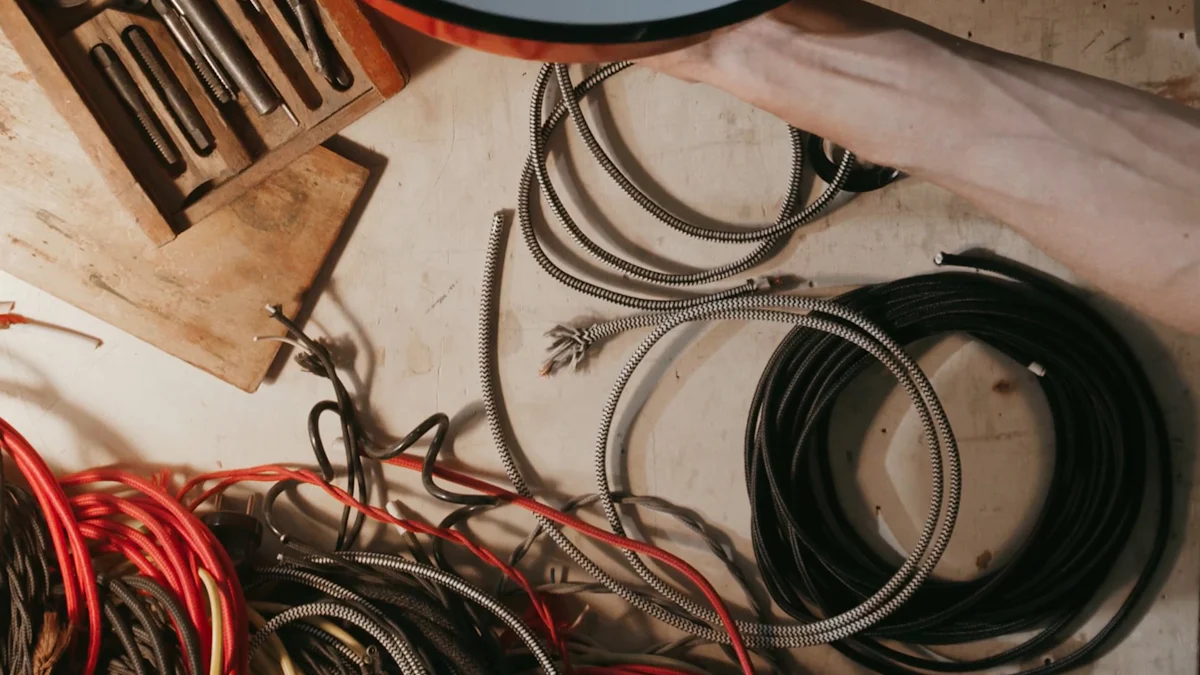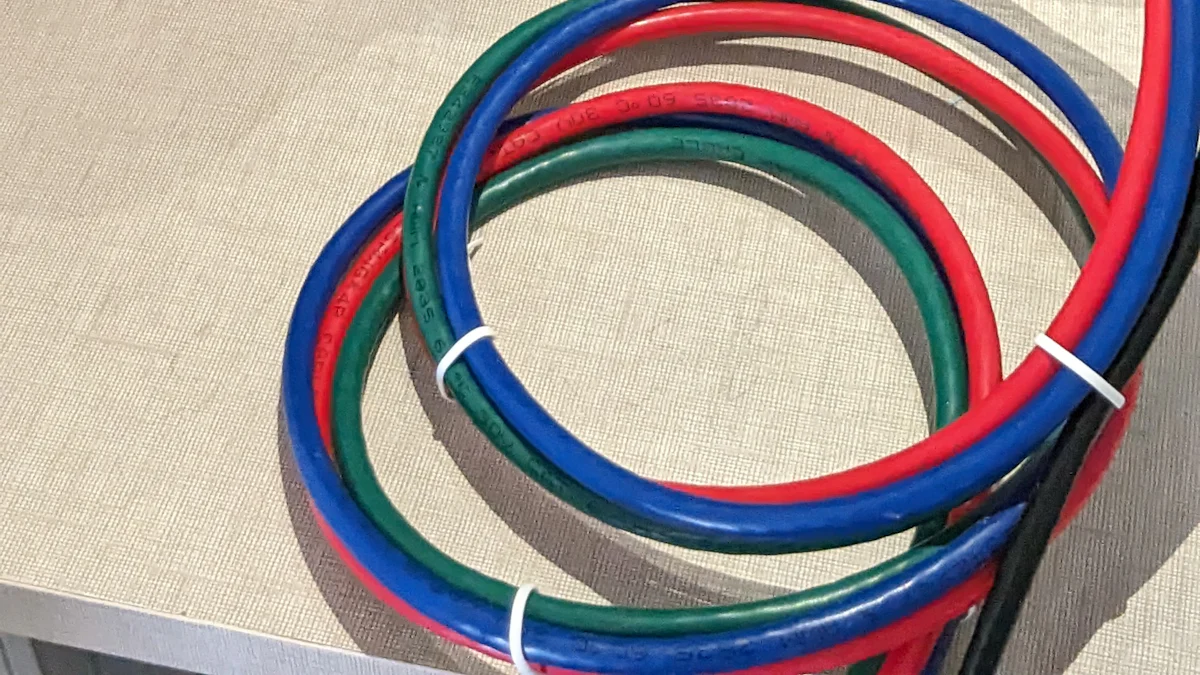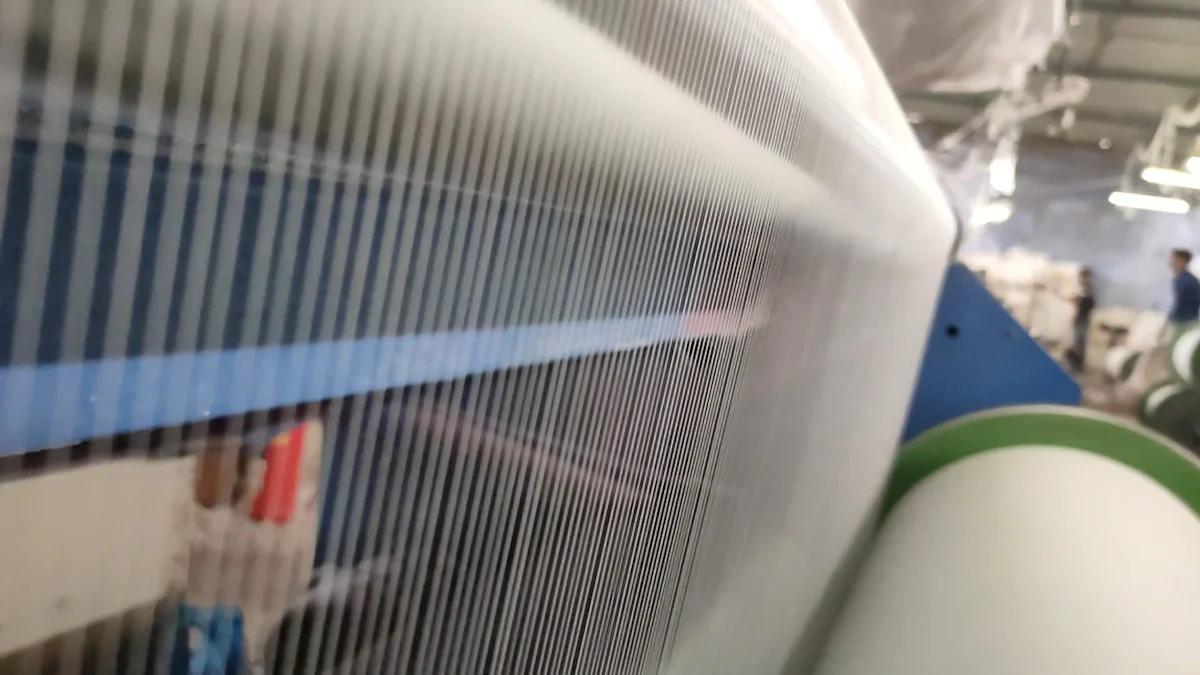Selecting the right cable material is crucial for ensuring the efficiency and safety of electrical systems. Cable materials, such as PVC, XLPE, and XLPO, play a vital role in various industries, including telecommunications, construction, and power distribution. These materials determine the cable’s performance, durability, and environmental impact. As the global wires and cables market grows, driven by urbanization and industrialization, understanding these materials becomes even more important. The demand for environmentally friendly cables is rising, reflecting a shift towards sustainable solutions in the industry.
Key Takeaways
- Choosing the right cable material is essential for the efficiency and safety of electrical systems, impacting performance and longevity.
- PVC is a cost-effective and flexible option ideal for residential wiring, but it has limitations in high-temperature environments.
- XLPE offers superior heat resistance and electrical insulation, making it suitable for high-voltage applications and underground installations.
- XLPO provides excellent chemical resistance and flexibility, making it the preferred choice for automotive and industrial settings.
- Consider environmental factors and sustainability when selecting cable materials, as the demand for eco-friendly options is on the rise.
- Recycling cable materials can significantly reduce waste and conserve resources, contributing to a more sustainable industry.
- Evaluate project requirements, including budget, application environment, and chemical exposure, to make informed decisions on cable material selection.
Understanding Cable Materials
What Are Cable Materials?
Cable materials form the backbone of electrical systems, providing essential insulation and protection. These materials include PVC (Polyvinyl Chloride), XLPE (Cross-Linked Polyethylene), and XLPO (Cross-Linked Polyolefin). Each material offers unique properties that cater to specific applications. For instance, PVC is known for its flexibility and cost-effectiveness, making it a popular choice for residential wiring. On the other hand, XLPE provides superior heat resistance and electrical insulation, ideal for high-voltage applications. XLPO stands out with its enhanced chemical resistance and toughness, suitable for demanding environments like automotive and industrial settings.
Cable materials not only determine the physical characteristics of the cables but also influence their performance and longevity. The choice of material affects the cable’s ability to withstand environmental factors such as temperature fluctuations, moisture, and chemical exposure. For example, XLPE insulated cables offer high tensile strength and better protection in harsh environments, reducing the risk of environmental stress cracking. This makes them suitable for long-term use in challenging conditions.
Why Do Cable Materials Matter?
The significance of cable materials extends beyond mere insulation. They play a crucial role in ensuring the safety and efficiency of electrical systems. Proper selection of cable materials can prevent electrical failures, reduce maintenance costs, and enhance the overall reliability of the system. For instance, XLPO insulation cables provide excellent thermal, chemical, and mechanical protection, making them ideal for high-voltage and industrial applications.
Moreover, the environmental impact of cable materials is becoming increasingly important. The demand for environmentally friendly cables is on the rise, driven by the need for sustainable solutions. These cables are made from recyclable materials and designed for energy efficiency and durability. Choosing the right cable material not only meets the technical requirements but also aligns with environmental goals.
PVC (Polyvinyl Chloride) PVC
Characteristics of PVC
Flexibility and Durability
PVC, or Polyvinyl Chloride, stands out for its flexibility and durability. This material bends easily, making it ideal for applications where cables need to navigate tight spaces or corners. Its robust nature ensures that it withstands physical stress without breaking, which is crucial in maintaining the integrity of electrical systems. PVC’s ability to endure wear and tear makes it a reliable choice for many projects.
Cost-Effectiveness
One of PVC’s most appealing features is its cost-effectiveness. Compared to other cable materials, PVC offers a budget-friendly option without compromising on quality. This affordability makes it a popular choice for large-scale projects where cost control is essential. Its widespread availability further enhances its appeal, ensuring that it remains a staple in the cable industry.
Advantages and Disadvantages
Pros of Using PVC
- Affordability: PVC is less expensive than many other materials, making it accessible for various applications.
- Flexibility: Its pliable nature allows for easy installation in complex layouts.
- Durability: PVC resists physical damage, ensuring long-lasting performance.
Cons of Using PVC
- Temperature Limitations: PVC does not perform well in high-temperature environments, which can limit its use in certain applications.
- Environmental Concerns: The production and disposal of PVC can pose environmental challenges, as it is not as eco-friendly as some alternatives.
Ideal Applications for PVC
Common Uses in Residential Wiring
PVC’s characteristics make it an excellent choice for residential wiring. Its flexibility allows for easy installation in homes, where cables often need to fit into tight spaces. Additionally, its cost-effectiveness makes it suitable for budget-conscious homeowners and builders.
Limitations in High-Temperature Environments
While PVC excels in many areas, it has limitations in high-temperature environments. It cannot withstand extreme heat, which can lead to degradation and failure. For applications requiring high thermal resistance, other materials like XLPE may be more appropriate.
XLPE (Cross-Linked Polyethylene)
Characteristics of XLPE
Heat Resistance
XLPE, or Cross-Linked Polyethylene, stands out for its remarkable heat resistance. This material can endure temperatures up to 120°C without melting, making it suitable for applications that demand high thermal stability. Its ability to withstand extreme heat ensures that cables maintain their integrity and performance even in challenging environments. This characteristic makes XLPE a preferred choice for installations where temperature fluctuations are common.
Electrical Insulation Properties
The electrical insulation properties of XLPE are exceptional. It offers superior dielectric strength, which enhances its ability to insulate electrical currents effectively. This feature reduces the risk of electrical failures and ensures reliable performance over time. Additionally, XLPE exhibits low dielectric loss, which contributes to energy efficiency in electrical systems. Its resistance to environmental factors such as moisture and chemicals further enhances its insulation capabilities, making it a robust option for various applications.
Advantages and Disadvantages
Pros of Using XLPE
- High Thermal Stability: XLPE can handle high temperatures, making it ideal for environments with significant heat exposure.
- Excellent Insulation: Its superior dielectric strength ensures effective insulation, reducing the risk of electrical failures.
- Durability: XLPE’s resistance to wear, chemicals, and environmental stressors ensures long-lasting performance.
Cons of Using XLPE
- Cost: XLPE tends to be more expensive than other cable materials, which may impact budget considerations for some projects.
- Complex Installation: The installation process for XLPE cables can be more complex due to their rigidity compared to more flexible materials like PVC.
Ideal Applications for XLPE
Use in High-Voltage Applications
XLPE is particularly well-suited for high-voltage applications. Its ability to carry higher voltages with reduced thickness and weight makes it an efficient choice for power distribution systems. The material’s excellent insulation properties ensure safety and reliability in these demanding settings.
Suitability for Underground Cables
The durability and environmental resistance of XLPE make it an excellent choice for underground cables. It can withstand the harsh conditions often encountered below ground, such as moisture and chemical exposure. This resilience ensures that underground cables remain operational and reliable over extended periods, reducing maintenance needs and enhancing system longevity.
XLPO (Cross-Linked Polyolefin)
Characteristics of XLPO
Enhanced Chemical Resistance
XLPO offers exceptional chemical resistance, making it a preferred choice for environments where exposure to harsh substances is common. This material withstands various chemicals without degrading, ensuring the longevity and reliability of the cables. Its robust nature makes it suitable for applications in industries where chemical exposure is a concern, such as automotive and industrial settings.
Flexibility and Toughness
The flexibility of XLPO sets it apart from other cable materials. It maintains pliability even in cold temperatures, allowing for easy installation in complex layouts. This flexibility, combined with its toughness, ensures that cables can navigate around obstacles without compromising structural integrity. The cross-linked structure of XLPO enhances its durability, making it resistant to wear and tear over time.
Advantages and Disadvantages
Pros of Using XLPO
- Chemical Resistance: XLPO resists a wide range of chemicals, ensuring durability in harsh environments.
- Flexibility: Its ability to bend easily makes it ideal for intricate installations.
- Fire Resistance: XLPO’s inherent fire-resistant properties reduce combustion risks, enhancing safety.
Cons of Using XLPO
- Cost: The advanced properties of XLPO may result in higher costs compared to simpler materials.
- Environmental Impact: While more eco-friendly than some alternatives, XLPO still contributes to plastic waste.
Ideal Applications for XLPO
Use in Automotive and Industrial Settings
XLPO excels in automotive and industrial applications due to its resilience and flexibility. It handles the demanding conditions of these environments, providing reliable performance. Its chemical resistance ensures that it remains unaffected by oils and other automotive fluids, making it a dependable choice for vehicle wiring systems.
Example of Automotive Cable
In the automotive industry, XLPO is often used in models requiring high durability and flexibility. For instance, it is commonly found in wiring harnesses that must navigate tight spaces and endure constant movement. This adaptability makes XLPO an essential component in modern vehicle design, where efficiency and reliability are paramount.
Comparing PVC, XLPE, and XLPO
Key Differences
When comparing PVC, XLPE, and XLPO, several key differences emerge that influence their suitability for various applications.
-
Insulation and Thermal Stability:
- XLPE offers superior insulation and higher thermal stability compared to PVC. It can withstand higher temperatures, making it ideal for high-voltage applications.
- XLPO also provides excellent thermal stability and enhanced performance, making it suitable for environments with fluctuating temperatures.
- XLPE offers superior insulation and higher thermal stability compared to PVC. It can withstand higher temperatures, making it ideal for high-voltage applications.
-
Durability and Environmental Resistance:
- XLPE and XLPO both exhibit greater resistance to environmental factors such as moisture and chemicals than PVC. This makes them more durable in harsh conditions.
- XLPO stands out for its chemical resistance, which is crucial in industrial and automotive settings.
- XLPE and XLPO both exhibit greater resistance to environmental factors such as moisture and chemicals than PVC. This makes them more durable in harsh conditions.
-
Cost and Environmental Impact:
- PVC is generally the most cost-effective option, making it popular for budget-conscious projects. However, it poses environmental concerns due to its production and disposal processes.
- XLPO is more expensive than PVC but offers better performance and is considered more environmentally friendly.
- PVC is generally the most cost-effective option, making it popular for budget-conscious projects. However, it poses environmental concerns due to its production and disposal processes.
Choosing the Right Material for Your Project
Selecting the appropriate cable material depends on the specific requirements of your project. Consider the following factors:
-
Application Environment: For high-temperature or high-voltage applications, XLPE is a suitable choice due to its thermal stability and insulation properties. In contrast, PVC may suffice for residential wiring where cost is a primary concern.
-
Chemical Exposure: If the cables will encounter harsh chemicals, XLPO provides the necessary resistance and durability. Its flexibility also aids in installations requiring intricate layouts.
-
Budget Constraints: Projects with tight budgets might favor PVC for its affordability, though it’s essential to weigh this against potential environmental impacts and performance limitations.
-
Environmental Considerations: For projects prioritizing sustainability, XLPO offers a more eco-friendly option compared to PVC, aligning with modern environmental goals.
By understanding these differences and considering the specific needs of your project, you can make an informed decision on the most suitable cable material.
Environmental Impact of Cable Materials
Sustainability Considerations
The environmental impact of cable materials has become a significant concern in recent years. As industries strive for sustainability, the development of environmentally friendly cables is crucial. These cables aim to reduce harmful materials, promote recyclability, and improve energy efficiency. Traditional materials like PVC have raised concerns due to their toxic production processes and difficulty in recycling. In contrast, newer materials such as XLPO offer more eco-friendly options, aligning with modern environmental goals.
Key Points on Sustainability:
- Reduction of Harmful Materials: Manufacturers are focusing on minimizing the use of toxic substances in cable production.
- Promotion of Recyclability: Efforts are being made to design cables that can be easily recycled, reducing waste and conserving resources.
- Energy Efficiency: Improved cable designs contribute to energy savings, which is essential for sustainable development.
Recycling and Disposal
Recycling plays a vital role in mitigating the environmental impact of cable materials. The disposal of electric cables can have significant environmental consequences, but recycling offers a solution to reduce these effects. By recycling cables, industries can conserve resources and minimize waste. This process not only helps in managing the disposal of cables but also supports the creation of a circular economy.
Benefits of Recycling:
- Resource Conservation: Recycling helps in preserving raw materials and reduces the need for new resources.
- Waste Reduction: Proper recycling practices decrease the amount of waste sent to landfills, lessening environmental pollution.
- Economic Advantages: Recycling can lead to cost savings by reusing materials and reducing the expenses associated with waste management.
In summary, understanding the distinct properties of PVC, XLPE, and XLPO is essential for selecting the right cable materials for specific applications. Each material offers unique benefits and limitations, influencing performance and environmental impact. For optimal results, consider the application’s environmental conditions, durability needs, and budget constraints. Durable materials like XLPE and XLPO enhance longevity and reduce maintenance, especially in demanding environments. By aligning material choice with project requirements, one can ensure efficient and reliable electrical systems.
FAQ
What are the main differences between PVC, XLPE, and XLPO cables?
PVC, XLPE, and XLPO cables differ primarily in their insulation properties and applications. PVC offers flexibility and cost-effectiveness, making it suitable for residential wiring. XLPE provides superior heat resistance and electrical insulation, ideal for high-voltage applications. XLPO stands out with enhanced chemical resistance and toughness, making it suitable for automotive and industrial settings.
Why is choosing the right cable material important?
Selecting the appropriate cable material ensures the efficiency and safety of electrical systems. The right material prevents electrical failures, reduces maintenance costs, and enhances system reliability. It also aligns with environmental goals by offering sustainable solutions.
How does the environmental impact of cable materials affect their selection?
The environmental impact influences cable material selection as industries move towards sustainability. Materials like XLPO offer more eco-friendly options compared to traditional materials like PVC, which have raised concerns due to toxic production processes and recycling challenges.
What are the ideal applications for XLPE cables?
XLPE cables excel in high-voltage applications due to their ability to carry higher voltages with reduced thickness and weight. They are also suitable for underground installations, where durability and resistance to environmental factors are crucial.
Can PVC cables be used in high-temperature environments?
PVC cables have limitations in high-temperature environments. They cannot withstand extreme heat, which can lead to degradation and failure. For applications requiring high thermal resistance, materials like XLPE are more appropriate.
What makes XLPO cables suitable for automotive and industrial settings?
XLPO cables offer exceptional chemical resistance and flexibility, making them ideal for automotive and industrial applications. They withstand harsh conditions and remain unaffected by oils and other automotive fluids, ensuring reliable performance.
How do cable designations help in selecting the right cable?
Cable designations provide essential information about the cable’s construction, insulation material, and intended use. Understanding these designations helps in selecting the right cable for specific applications, ensuring compatibility and performance.
Are there cost differences between PVC, XLPE, and XLPO cables?
Yes, there are cost differences. PVC is generally the most cost-effective option, making it popular for budget-conscious projects. XLPE and XLPO offer advanced properties but tend to be more expensive, impacting budget considerations.
How does recycling benefit the cable industry?
Recycling conserves resources, reduces waste, and supports the creation of a circular economy. It helps manage cable disposal, lessening environmental pollution and offering economic advantages through cost savings and material reuse.
What should be considered when choosing a cable material for a project?
Consider the application environment, chemical exposure, budget constraints, and environmental considerations. Each factor influences the choice of cable material, ensuring efficient and reliable electrical systems tailored to specific project needs.
Post time: Dec-14-2024



